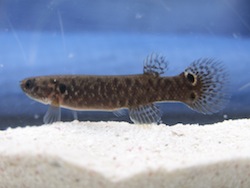How Mangrove Killifish deal with genetic diversity

Hermaphrodite Mangrove Killifish
29 October 2012
A team of researchers led by Dr. Sonia Consuegra nd her recently graduated PhD student Amy Ellison from IBERS have investigated how populations cope with low genetic diversity in a unique self-fertilising vertebrate (the mangrove killifish).
Mating between close relatives (inbreeding) reduces genetic diversity, making all individuals equally susceptible to environmental changes or diseases but, surprisingly, some populations seem to manage well and even thrive with low diversity. A team of researchers led by Dr. Sonia Consuegra and her recently graduated PhD student Amy Ellison from IBERS have investigated how populations cope with low genetic diversity in a unique self-fertilising vertebrate (the mangrove killifish).
Their work, published in Proceedings of the Royal Society and highlighted last week in Nature News, shows how genetic diversity in some parts of the genome (e.g. immune-related genes) can be more important than the rest in terms of survival of the species. Hermaphrodite mangrove killifish have high rates of inbreeding and are genetically very homogeneous, but are also able to outcross, thereby introducing new genetic diversity. By comparing genetic diversity at neutral parts of the genome (microsatellites), immune-related genes (MHC) and parasites in wild and laboratory reared fish, Aberystwyth researchers found that those individuals that had undergone more generations of self-fertilization had lower MHC and microsatellite diversity, and carried more parasites. But they also found evidence that the distribution of MHC alleles was not random, suggesting that even few divergent alleles could offer a selective advantage, potentially helping to fight a wider array of pathogens. Thus, even low levels of outcrossing could produce enough variability in immune-system genes to better resist parasites.
This research has an important implication for conservation: immune-related genes, such as the MHC genes, need to be considered in captive breeding programs to minimize the negative consequences of inbreeding in endangered species.



